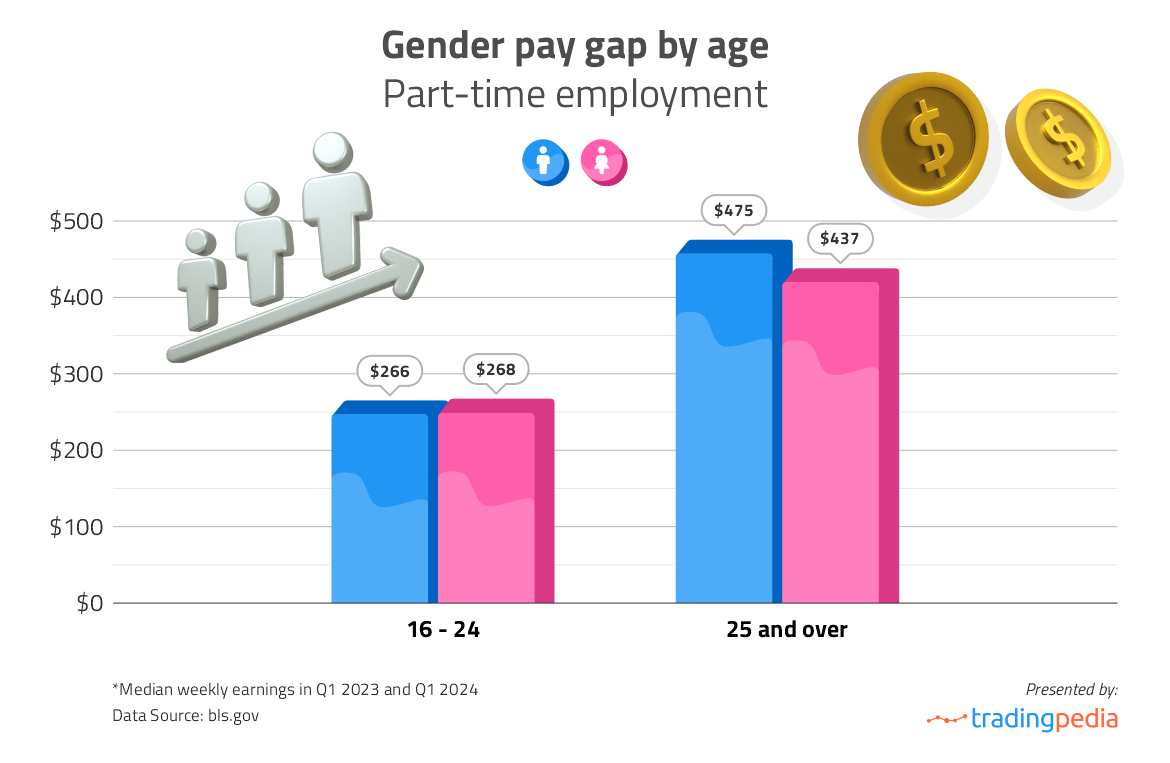For years, women have struggled with the gender pay gap, urging them to pursue higher education, work longer hours, and broaden their areas of employment. The issue still exists today even though the differences in payment are much smaller than they were a few decades ago. Curious to see how much society has done in the past couple of years to improve equal pay, our team at Tradingpedia compared earnings data for 2023 and 2024 in the United States.
We looked at figures for the first quarters of 2023 and 2024 from the U.S. Bureau of Labor Statistics (BLS), which reveal the existing pay gap between genders and different employee characteristics such as ethnicity, age, education, and employment type.
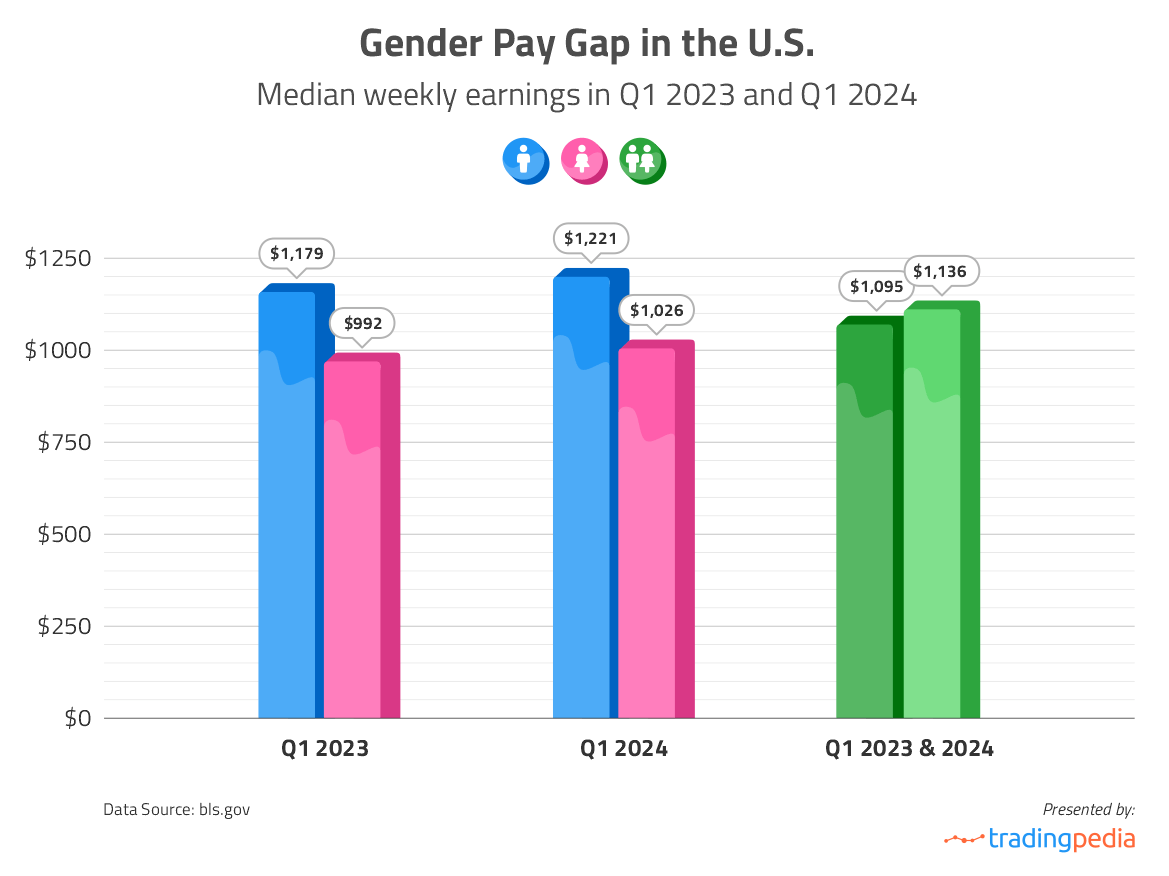
Here are some of our findings:
- In the first quarter of 2023, women in the U.S. made on average 84,15% of what men earned. Interestingly, in Q1 2024, women made even less, 84,03%, or just slightly over four-fifths of their male counterparts.
- Women’s median earnings in management were $1,375 per week as of Q1 2024, compared to the $1,875 earned by men for jobs in similar positions, a difference of 36.36%, which is also an increase of the gender gap by 4,29% since 2023.
- In production, female employees were paid approximately $752 per week, whereas male workers earned $904, 20.21% more.
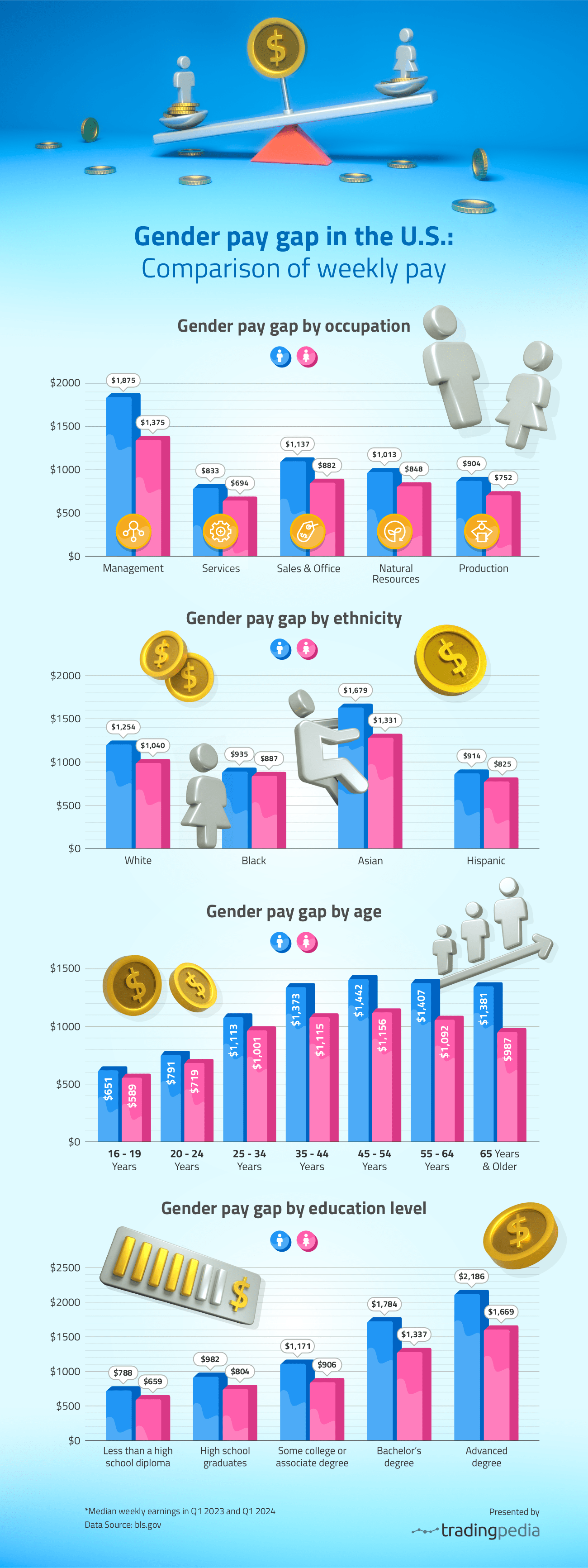
Gender pay gap by occupation
Although the pay gap in most fields of employment has increased by 1-10% from 2023 to 2024, the two occupation spheres that stand out are Production and Natural Resources. Men employed in production jobs now earn 20.21% more than women, compared to 31.25% in the first quarter of 2023. In the most predominantly male occupation industry, namely, Natural Resources, women have brought down the pay gap to only 16.29% in Q1 2024 from 34.06% in the same period in 2023. In Q1 2024, women’s median weekly earnings were $848, up from $664 in 2023, while men made $1,013, up $6 from $1,007.

Gender pay gap by ethnicity
Inflation has increased recently after months of rapid price increases brought on by the pandemic’s aftermath, steadily rising demand, supply chain disruptions, and Russia’s invasion of Ukraine. In January, the Consumer Price Index for all items increased by 3.1% year-over-year, a slowdown from the previous month, when it was 3.4%. However, inflation increased to 3.2% in February and to 3.5% in March, the highest rate since September.
Meanwhile, wages in the U.S. have slowly gone up. In the first quarter of 2024, the median weekly earnings of all full-time wage and salary workers were $1,136, up 3.74% from the same period in 2023. The median income of a male worker is $1,221 per week in Q1 2024, or 3.56% more compared to Q1 2023. The median earnings of female employees increased by 3.43%, reaching $1,026 per week, 15.97% less than men.
When it comes to pay differences within racial and ethnic groups, women of Hispanic or Latino background earned the least, $825 of median weekly pay. With an income of $1,679 per week, Asian men received the highest median earnings among all ethnicities and genders. White women earned 17.07% less than white men per week; black women earned 5.13% less than black men, Asian women earned 20.73% less than Asian men; Hispanic women earned 9.74% less than Hispanic men in Q1 2024. All gender-ethnic wage gaps have dropped from 2023, except between Asian men and women. The gender pay gap for this demographic group has increased by 4.2% in one year.
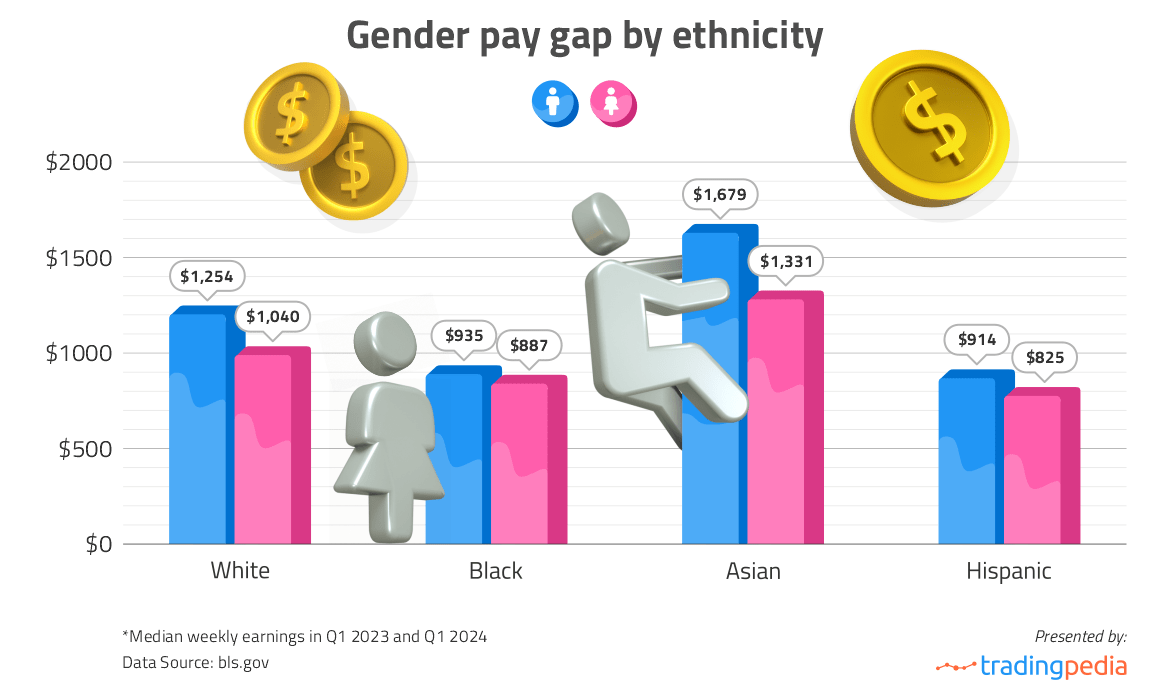
Gender pay gap by age
When it comes to the pay gap within the different age groups, men over their prime working years, between the ages of 45 and 54, earned the most per week – $1,442 of median income, and so did women in that age group – $1,156. However, we estimated that female workers’ payment was only 80.17% of what male employees received. The lowest median weekly wages were $651 and $589, respectively, for men and women between the ages of 16 and 19.
Within the 20–24 age group, the difference in earnings between male and female full-time workers was the lowest (9.1%). On the other hand, the pay gap between the sexes aged 55-64 and those aged 65 and older was the largest, at 22.39% and 28.53%, respectively. So, older men and women, have the greatest differences between their earnings.
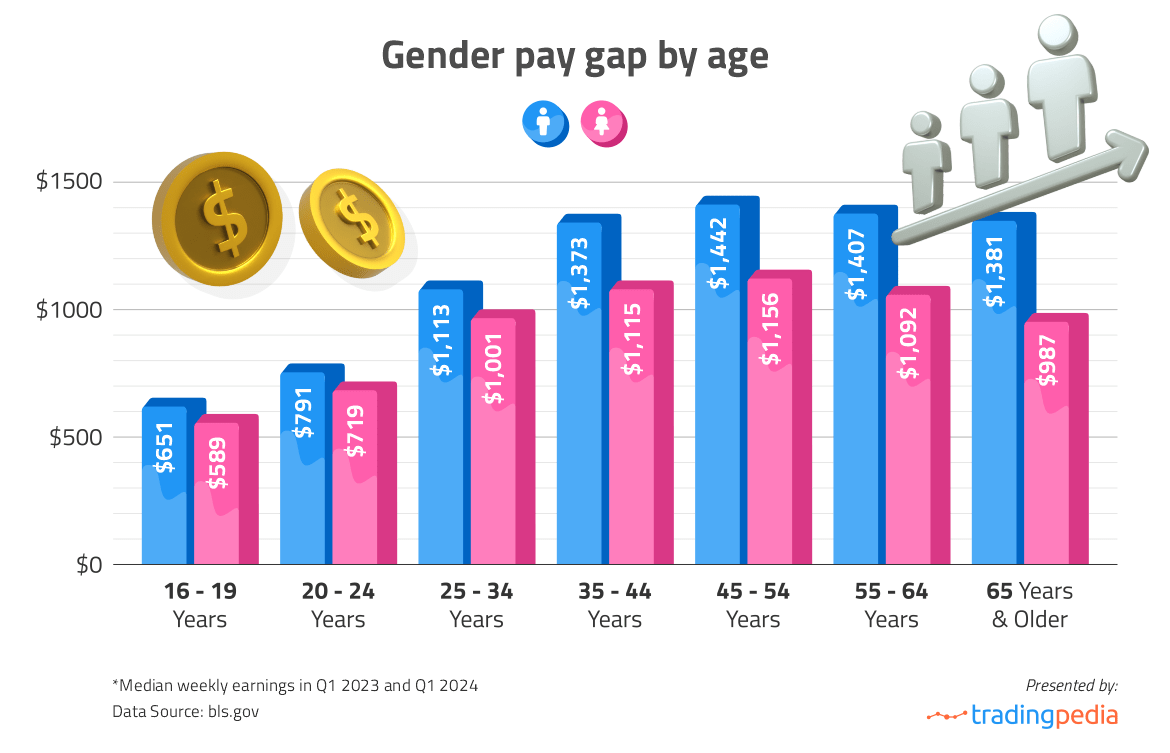
Gender pay gap by education
Male workers who were 25 years old and above had a median weekly wage 21.35% higher than their female counterparts with similar educational attainment. Full-time male workers who only graduated from high school and did not pursue further education received $982 of median weekly pay, compared to full-time female workers with the same education profile who received $804 per week, totaling only 81.87% of the male median earnings.
Women with some college education or associate degrees received just 77.37% of the male median salary, or $906 weekly, while men with the equivalent education earned approximately $1,171. The median income of full-time male workers with advanced degrees was 30.98% higher than that of full-time female employees with the same level of education. The greatest difference in the median earnings, based on educational attainment is between men and women with Bachelor’s degrees, where full-time female workers earn the belittling 74.94% of the male weekly income.
What’s even more intriguing is that according to the BLS statistics, the highest-earning 10% of male employees with some college education or associate degree made on average $2,310 per week, compared to the highest-earning 10% of female employees with the same level of education who made about $1,679 per week. This represents a difference of $631 or 37.58% more for male workers. Furthermore, the highest-earning 10% of male employees with an educational status of “less than a high school diploma” earned approximately 35.50% more than their female counterparts.
On the other hand, the wage gap between the lowest-earning 10% of male and female workers with an education status of less than a high school diploma degree is a weekly payment of only 7.83% more in favor of men. When considering workers with a Bachelor’s degree in the first decile of the population, men earned around $834 per week, whereas women made 15.35% less than that ($706).

The gender pay gap in part-time jobs
Due to the many cutbacks during the COVID-19 pandemic and the additional caregiving responsibilities many people had to undertake, part-time jobs became an increasingly popular option for many Americans. This is the only category where some women earned more than men in 2023 and 2024. Female workers between 16 and 24 years earned $268, compared to male part-time employees, who made around $266, or 0.75% less in 2024. On the other hand, part-time female workers, aged 25 years and older, earned $437 per week compared to $475 for part-time male workers, which is 8.7% more in favor of men.
Contrary to full-time workers, where Hispanic men and women earned the least, in the first quarter of 2023, Latino men in part-time jobs earned the most for male employees from all ethnic groups ($392 weekly). Out of all women, those from Asian backgrounds were the most well-paid demographic, earning $415 a week, an astounding 14.01% more than Asian men.
In 2024, however, the tides turned somewhat, as Asian men were the most well-paid demographic, earning $434 a week, or 2.12% more than Asian women in part-time jobs and 19.23% more than white men. Nevertheless, black women earned 10.78% more than black men, while the difference between white male and female part-time employees was $18 in favor of the ladies.
